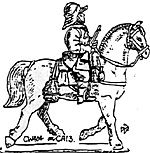by Bill Johnson and David Ratcliffe.
Published by Redoubt Enterprises
Cost £5, A4, 40 p.
 These are more than just skirmish game rules. They cover the raising and hiring out of a company of mercenaries during that period of time generally (if mistakenly) called the Renaissance. In wargame terms, here defined as roughly the end of the Hundred Years war to the beginning of the Thirty Years war, although the core of the period covered is clearly the Italian and Bugundian Wars of the later 15th and early 16th centuries. This period is also well supported by Redoubt's very nice renaissance range of 28 mm figures.
These are more than just skirmish game rules. They cover the raising and hiring out of a company of mercenaries during that period of time generally (if mistakenly) called the Renaissance. In wargame terms, here defined as roughly the end of the Hundred Years war to the beginning of the Thirty Years war, although the core of the period covered is clearly the Italian and Bugundian Wars of the later 15th and early 16th centuries. This period is also well supported by Redoubt's very nice renaissance range of 28 mm figures.
So what do you get? The first half or so of the book deals with raising your mercenary company, bidding for jobs and organising writing a scenario. These rules are neat, if you have a number of players, as you can bid money on espionage and learn of your opponent's missions. You can also spend money on troops of various kinds, armour and specialist, which include assassins, surgeons, engineers and thieves. All in all, some very interesting skulduggery is possible, assuming that you have the opponents for it.
As a solo gamer, of course, the interactive element is missing (although I'm sure that an interesting PBM or PBeM game could be had on the basis of these rules), but the advantage is that, with the mission selection process, a scenario practically writes itself for you. In my playtest, I had the Glorious Swiss Grisons up against the shifty looking Company D'Or, a bunch of dubious looking Burgundian mercenaries. For missions, the Swiss were to escort a convoy of wagons across the board, and the Burgundians got a 'major battle' which allowed them to engage the Swiss anywhere. In keeping with the times, the Swiss were a force of pikes and halberds and the Burgundians a fine mix of gendarmes, longbow, pikes and arquebusiers.
The second half of the book is the combat rules, and very smoothly they play too, being clearly set out, with a summary in the centre pages.
 The rules are fairly well what you would expect from a skirmish game. Your figures are rated as raw through to expert, with additions and subtractions for wounds, being on horseback and so on. They move swiftly and seamlessly, with only a limited amount of bookwork. I do feel that ranged weapon ranges are a bit too long, or at least that they are too effective at long range, but maybe that is because the Glorious Grisons omitted to obtain anyone with ranged weapons, and suffered for it.
The rules are fairly well what you would expect from a skirmish game. Your figures are rated as raw through to expert, with additions and subtractions for wounds, being on horseback and so on. They move swiftly and seamlessly, with only a limited amount of bookwork. I do feel that ranged weapon ranges are a bit too long, or at least that they are too effective at long range, but maybe that is because the Glorious Grisons omitted to obtain anyone with ranged weapons, and suffered for it.
Post battle you have a little work to do, obtaining your pay, sorting loot and treasure, gaining experience and recovering from wounds ready for your next mission. For the record, the Glorious Grisons were rather shot up by the time they reached the Bugundian lines, and routed ignominiously, leaving a total victory to the hordes of Charles the Twit. They are now licking their wounds and casting around for some arquebusiers to join them. Any offers?
All in all, a good treatment of an unusual subject, and the set up is one of the more innovative I've seen. While historically mercenary companies might have been bigger than the numbers represented here, there is no reason for that to get in the way of a very good game. I have no hesitation in recommending these rules, even if Renaissance is not your scene. The set up for the game has many other applications.
Back to Table of Contents -- Lone Warrior #131
Back to Lone Warrior List of Issues
Back to MagWeb Magazine List
© Copyright 2000 by Solo Wargamers Association.
This article appears in MagWeb (Magazine Web) on the Internet World Wide Web.
Other military history articles and gaming articles are available at http://www.magweb.com
